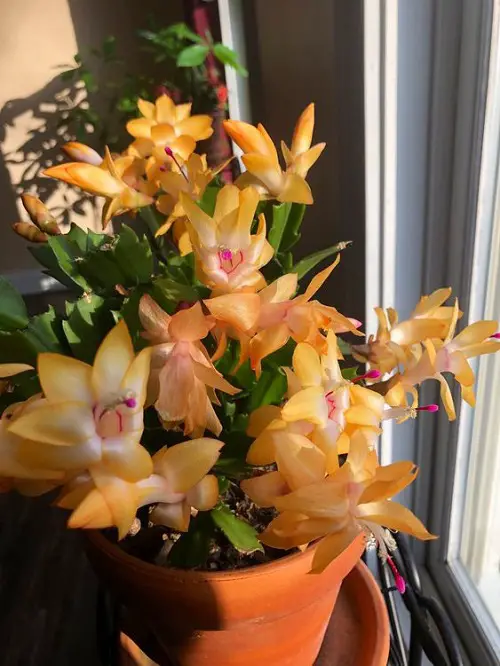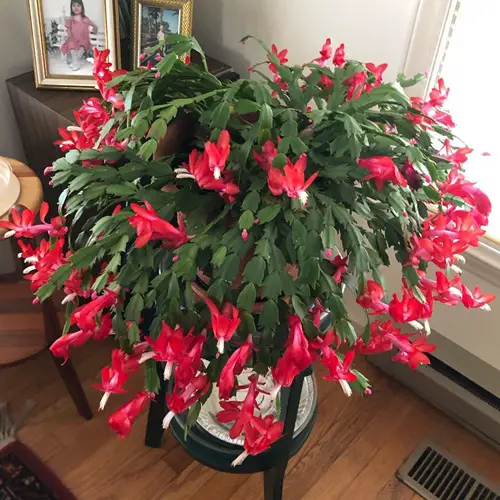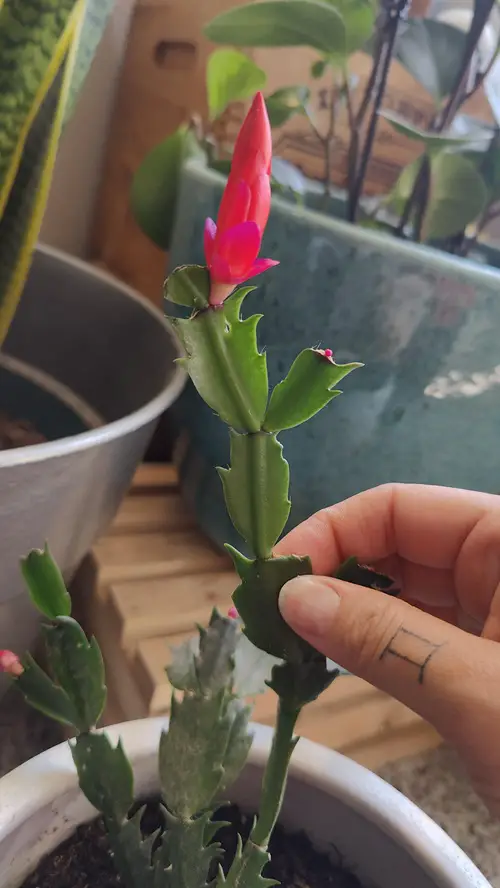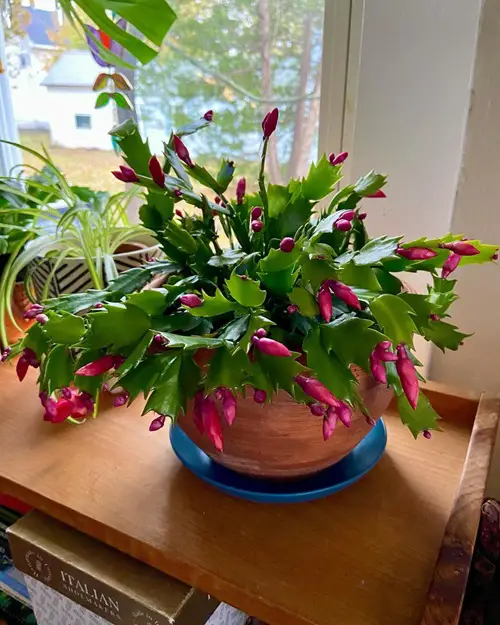Here is How to Make Thanksgiving Cactus Bloom on Time to enjoy its beautiful flowers around the holiday season and beyond!

Without those vivid-colored blooms, your Thanksgiving cactus will look dull. Don’t worry; we have excellent gardening tips to make your cactus bloom earlier, on time, and beyond.
Thanksgiving Cactus Blooming Time
Thanksgiving cactus usually blooms from late fall through winter, right on time for holidays and celebrations. Flowers appear around Thanksgiving, which is the fourth Thursday of November! The blooming period lasts around 7-8 weeks, sometimes longer.
If you’re lucky, your Thanksgiving cactus flowers will fall off and return again in spring under favorable conditions, including hours of light and night. Autumn and winter months have shorter days, followed by colder and darker nights, which trigger the flowering.
Thanksgiving Cactus vs Christmas Cactus

Many people confuse these two because they look very similar. It can be tricky to tell the difference between a Thanksgiving cactus and a Christmas cactus if you don’t know what to look for.
There are two ways to differentiate: Look at the flowers! If they are long and tubular with fused petals, you’re looking at a Thanksgiving cactus. On the other hand, if its blooms are shorter and have more rounded petals that are separate, you’ve got a Christmas cactus.
But what about the specimens that don’t have the flowers yet? Simple. The Thanksgiving cactus has pointy, claw-like projections on its leaves, but those on the Christmas cactus are less sharp-edged. They’re scalloped, like a teardrop, and that’s how you tell them apart.
How to Make Thanksgiving Cactus Bloom on Time
1. Control the Light

Your Thanksgiving cactus will do well under indirect light. Remember to place it in a spot with less than 12 hours of indirect sunlight, preferably a few feet away from a window. And use a sheer curtain to filter the light.
The best spot would be an east-facing window that receives gentle morning sun and then indirect light all day!
Some varieties can also withstand more light hours, but we recommend avoiding this as it needs at least six weeks of dark hours to bloom well.
To create darkness at night, keep your plant in the closet or cover it with a loose black plastic bag for 12 hours. Depending on your region, September or fall is the perfect time to start this process.
2. Cut Back on Watering
As we enter fall and the pre-blooming phase, begin cutting back on watering your Schlumbergera. Remember that this is when the weather cools down, and your cactus doesn’t need more frequent saturation, like in spring or summer.
Wait for the top layer of soil to dry out between watering spells, or water usually around every 2-3 weeks.
So how does this help? This lack of water stresses the plant out just enough to trigger bud formation in the upcoming months. It happens because this condition mimics its natural habitat and the period of dryness it receives there, signaling it to prepare for blooming.
Don’t dehydrate it fully, and avoid underwatering. If you see the segments discoloring or turning yellow, moisten the plant deeply to nurse it back to health.
3. Pinch the Thanksgiving Cactus

Pinching and pruning are the most essential techniques for blooming, and your Thanksgiving cactus is no different. Pruning is best done after a blooming cycle in the summer months. It will help you get a bushier and fuller cactus.
Pinch back the growing tips or terminal buds in spring, around early June, which helps sprout more shoots. Carefully remove them using your fingernails or a clean pair of pruning shears.
If you see an immature stem on your Thanksgiving cactus, you can prune it until fall. Usually, these stems do not flower, and removing them will help the plant use that energy for flowering instead.
Note: Pruning or pinching is best done in spring and early summer and should be avoided after mid-summer to promote blooming in fall.
4. Give it the Right Temperature

Keeping your Thanksgiving cactus in the right temperature is crucial to ensure it blooms. Between spring and fall, maintain 70-80 F (21-26 C) around your plant for the best blooms in the winter. Once you see that the flower buds are set, never let the temperature climb over 90 F (32 C), as this will cause the flowers to fall off before emerging fully.
And pair darkness with low temperatures just a month before the blooming season. You could also keep the plant outside at night if you live in a mild climate.
If you want the best blooms in fall and winter, ensure the minimum nighttime temperature does not fall below 55 F (12 C) and the daytime temperature does not exceed 70 F (21 C) from Mid September to Early November.
5. Make Sure the Humidity is Just Right
Just as you’ve paid attention to the temperature, ensure a 50-60% humidity range for blooms to prevent bud drop. Especially in summer and fall, the air can dry out quickly in some regions. You may find it useful to invest in a humidifier!
Else, fill a tray with pebbles and water, and keep it near your plant. As the water evaporates, the humidity around the plant will increase slightly. Here are a few other ways to increase humidity.
6. Don’t Skip the Fertilizer
The secret to growing the Thanksgiving cactus and making it bloom right on time is fertilizing it correctly. The best type of fertilizer for this succulent is any balanced, water-soluble formula. Look for one with equal amounts of nitrogen, phosphorus, and potassium and trace elements.
To prevent chemical burn and damaged roots, dilute the fertilizer to half or quarter of its manufacturer’s recommended strength and apply it once every 2-4 weeks during the growing season in spring and summer.
Stop fertilizing in early fall (mid to late September) to promote better flower bud formation. In comparison to other flowering plants, this flowering cactus needs more magnesium, so adjust accordingly. You can begin fertilization again in early spring, once the flowering period ends.
That’s it! Follow these steps now, and you’ll be thanking your Thanksgiving cactus very soon for its stunning blooms. And like the Christmas cactus, following these steps a month after blooming will coax it to flower again in fall. Do let us know how it goes for you in the comments!



